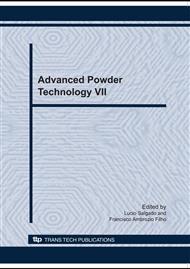p.158
p.164
p.170
p.176
p.182
p.188
p.194
p.203
p.209
Cobalt-Based Binders and the Efficiency of Diamond Saw Blades
Abstract:
Powder metallurgy-based technologies of saw blades production for stone cutting normally uses cobalt as binder agent. Cobalt was chosen for that purpose because it provides improved properties, high wettability and good adhesion between dispersed diamond particles. In addition to its excellent physical properties, cobalt also shows a positive behavior associated with the control of diamond graphitization at temperatures up to 1000°C. In this work, an experimental planning method supported by a mathematical algorithm was used to study the influence of doping agents incorporated into cobalt-based binders. The consequences on the wear resistance of saw blades, as well as on other physical and mechanical properties of the “diamond-cobalt-doping agent” composites were investigated. Cr3C2, Si, Ni and Fe were used as doping agents. Experimental tests were carried out using granite as a base material for wear and cutting operations.
Info:
Periodical:
Pages:
182-187
Citation:
Online since:
October 2010
Price:
Сopyright:
© 2010 Trans Tech Publications Ltd. All Rights Reserved
Share:
Citation:


